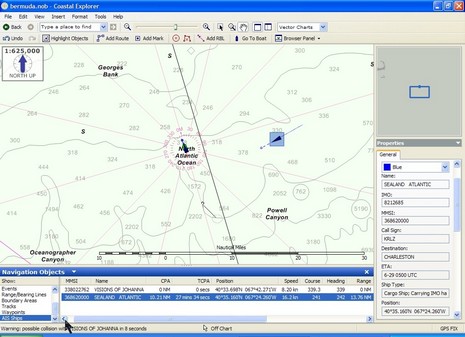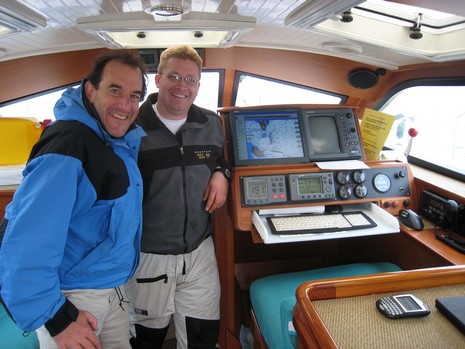AIS Class B, real world #1

Check out the full size version of this Coastal Explorer (aka Maptech Chart Navigator Pro) screen. It shows how useful the Nauticast B AIS transponder was during the Bermuda-to-Maine passage, and suggests how it might have played a critical role. You can see that we’re just coming onto the continental shelf. It was no surprise that we drove right into a classic Georges Bank blanket of fog, but reassuring that the Nauticast B’s dual receivers picked up the Sealand Atlantic at about 25 miles, more so knowing that we were going to pass ahead of it with a wide CPA. Visions of Johanna’s 4kw open array Furuno NavNet radar didn’t pick up the ship (bow on) until about when this screen was made, and it wasn’t even a large target when broadside 10 miles astern. Had we been 10 miles further back on our track, and without AIS, the crossing might have been nerve wracking.
The Sealand Atlantic did not answer my VHF call, so I don’t know if it ever saw our AIS signal, but by that time I had a high level of confidence that it would have from at least 6 miles and probably 10. I had already had responses from the other 7 ships I called, five of which saw us at 6 to 11 miles. The two that couldn’t see us were 10–12 miles away.
Unfortunately AIS did not help us with the fishing boats that we could hear chattering around us on VHF once we got on the banks. I was off watch by then but apparently we passed a little over a mile from two though never saw their lights, just radar targets acting oddly (as the boats dragged their nets). It’s nice to know that once Class B is FCC approved the Coast Guard plans to mandate their use on many of those vessels. Finally, note how Vision’s own AIS info is in the Nauticast’s NMEA 0183 stream, just like that of other targets and the unit’s GPS. The result, a little glitch I guess, is that Coastal Explorer warned us of a imminent collision with ourselves all the way to Maine (see bottom of the screen)!
PS 7/1: Some good tips from gCaptain on how to use AIS to really get a ship’s attention.













I WANT ONE!!!!!!
When is the bloody FCC going to get off the dime and get this approved.
Dan
Capt Dan Gingras
O461 LIONHEART
Portsmouth NH
http://www.daniel.gingras.net
Me too! We can hardly wait to get our hands on one and give it a proper stress-test here in crowded Puget Sound.
Tim Flanagan
Managing Editor
Navagear.com
If you had a DSC enabled VHF you could have placed a call to the other vessel’s bridge using their MMSI, no?
Terry
Ben,
It may have been that the AIS was ‘hearing itself’ when it transmitted so CE had no way to know that it was you — I don’t remember a ‘Ignore my MMSI’ feature in CE, but it might be a useful one to add.
Brian